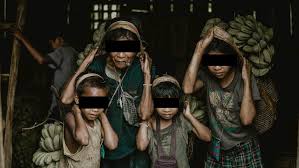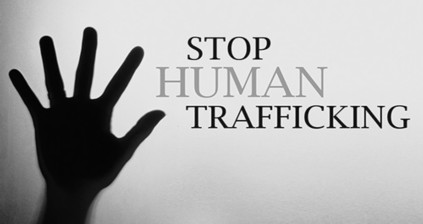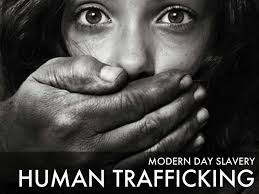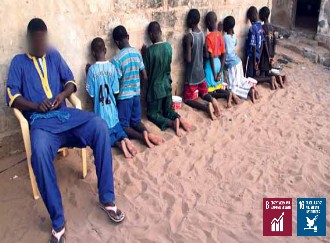| |||||||||||||||||||||||||||||||||||||||||||||||||||||||||||||||||||||||||||||||||||||||||||||||||||||||||||||||||
|
|
| ||||||||||||||||||||||||||||||||||||||||||||||||||||||||||||||||||||||||||||||||||||||||||||||||||||||||||||||||
|
ТЕМА 12. Противодействие торговле людьмиUnit 12
Combating Trafficking in Human Beings
Trafficking in human beings is highly profitable and is considered to be the third largest illegal trade in the world after illegal drugs and arms trafficking. A number of factors have led to its expansion, such as:
According to the international studies there are several different types of networks operating in this market. For example, there are large organizations with international structure and contacts at every level of society in the countries of origin, transit and destination. There are also small organizations and individuals that exploit human beings who are in a vulnerable situation. Human trafficking usually (but not always) includes three main stages: recruitment, transportation and exploitation. Recruitment. Social and economic reasons, poverty are often important contributing factors to people falling victims to trafficking. “Recruiters” play the main role in the process of the recruitment. They supply “goods” to the trafficking market. Women are typically recruited with promises of good jobs in other countries. Modern technologies, such as Internet, are used by recruiters more often. In a global network, there are sites of so-called marriage agencies, which contain catalogues of the “goods”.Traffickers can also use kidnapping, fraud, intimidation and physical force. Transportation. Traffickers have developed a number of different methods for introducing human beings into the country of destination. Some of them use legal travel documents and tourist visas to get them into a country and then send them on to another country “legally”. Sometimes these persons are equipped with false documents. Exploitation. The third stage of human trafficking is exploitation. There are different forms of exploitation. Men are exploited as builders and miners; women are exploited as house workers, seamstresses and dish washers. Women also face another form of exploitation – forced sex labour. Children are used in the sex industry and for begging. Many victims are forced to donate their organs for transplantation. Trafficking in human beings is modern slavery. Traffickers take away the basic human rights and freedoms of their victims: the freedoms from slavery and torture, freedoms to movement and residence, the rights to marry and have family, etc. Human trafficking is not the same as people smuggling. A smuggler illegally enters into a country for a fee, but on arrival at his destination, a smuggled person is free; a trafficking victim is enslaved. To prevent and combat human trafficking it is necessary:
A
Exercise 1. Give the English for: Торговля людьми; вербовка, перевозка и получение людей; применение насилия; с целью эксплуатации; распространение; легкие доходы от эксплуатации; недостаток информации; недостаточные наказания; согласно международным исследованиям; эксплуатировать людей; факторы, способствующие виктимизации; рынок незаконной торговли; доставление людей в страну назначения; принудительный труд; фальшивые документы; современное рабство; отнимать основные права и свободы; контрабанда людей, информировать население, уязвимое положение, делиться опытом.
Exercise 2. Match English and Russian equivalents:
Exercise 3. Complete the sentences: 1) Human trafficking is … 2) Human trafficking usually includes … 3) The first stage of human trafficking is… 4) To recruit their victims “recruiters” use … 5) The second stage of human trafficking is … 6) Traffickers can use legal travel documents or … 7) The third stage of human trafficking is … 8) Men are exploited as … 9) Women are exploited in … 10) Children are exploited in … 11) To combat trafficking in human beings it is necessary …
Exercise 4. Agree or disagree: 1) Trafficking in human beings is the third largest illegal trade in the world. 2) Human trafficking is the trade of donor organs. 3) According to the international studies there is one network operating in human trafficking. 4) The Internet isn’t used to recruit victims of human trafficking. 5) Traffickers have failed to develop new methods for introducing human beings into the country of destination. 6) Traffickers take away the basic human rights and freedoms of their victims. 7) The trafficking in human beings a new phenomenon. 8) Discrimination against women is the only factor, which have led to the expansion of human trafficking. 9) Human trafficking is just the same as people smuggling. 10) There are no effective methods of combating human trafficking.
Exercise 5. Answer the questions: 1) What is human trafficking? 2) Why is trafficking in human beings highly profitable? 3) What methods are used for recruiting victims? 4) What methods are used by traffickers for introducing human beings into the country of destination? 5) Traffickers use fraud, intimidation and use of physical force, don’t they? 6) Why do women and children fall victims to trafficking? 7) What are the forms of human trafficking? 8) What factors have led to the expansion of human trafficking? 9) What is the difference between human trafficking and people smuggling? 10) What should be done to combat human trafficking?
B
Exercise 1. а) Form the Gerund, using the model. Translate the Gerund into Russian: Model: to traffic – trafficking – торговля To traffic, to recruit, to obtain, to subject, to exploit, to kidnap, to transport, to smuggle, to combat.
b) Make sentences using the Gerunds from part a). Model: Trafficking is the term to define the illegal trade.
Exercise 2. Find sentences with the Gerund in the text “Combating Trafficking in Human Beings”. Translate them into Russian, paying attention to the Gerund.
Exercise 3. Transform the sentences according to the model. Translate them into Russian: Model: To smuggle is to move something or someone illegally into or out of a country. – Smuggling is moving something or someone illegally into or out of a country.
1. To beg is humiliating. 2. To introduce victims into the country of destination with legal travel documents and tourist visas is the legal method of transportation. 3. To exchange the information on criminal activity with other countries is the effective method to combat crime. 4. Countries should continue to cooperate in combating human trafficking. 5. To target the victims instead of criminals is unfair.
Exercise 4. Find Participle I, Participle II or the Gerund in the sentences. Translate the sentences into Russian: 1. Trafficking in persons is the fastest growing criminal industry in the world. 2. The low start-uр capital required is attractive to many non-professional as well as professional criminals, who see the opportunity created by the demand and have access to vulnerable people to exploit. 3. The influence of large organized criminal groups is often restricted to limited geographic areas and to certain roles within the human trafficking networks. 4. Much human trafficking occurs through decentralized criminal networks, or small groups of criminals that specialize in certain areas of а network, such as recruitment, transportation, or operating the “retail” end. 5. Traffickers make money by forcing or tricking people into prostitution, begging, or manual labour. 6. Other forms of human trafficking include bonded sweatshop labour, forced marriage, and domestic servitude. 7. In many cases corrupt officials facilitate human trafficking, accepting bribes to falsify documents and provide protection. 8. Many governments treat trafficked persons as illegal aliens, criminals, or both, exposing them to further abuse. 9. The Human Rights Based Approach to address trafficking means centring the human rights of trafficked persons in all anti-trafficking activities. 10. The Global Alliance Against Traffic in Women (GAATW) supports sharing of knowledge, working experiences and working methodologies amongst its members, in order to enhance the affectivity of collective anti-trafficking activities.
C Exercise 1. Read and translate the text:
The Profits of Trafficking in Human Beings
Trafficking in persons is the fastest growing criminal industry in the world for two primary reasons: 1). high profits can be made quickly, with little or nо start-up capital, and profits can be derived over а long period of time from the same victims (unlike drugs, which are quickly used up), and 2). despite of its criminal nature, the risk of prosecution is usually negligible. The low start-uр capital required is attractive to many non-professional as well as professional criminals, who see the opportunity created by the demand and have access to vulnerable people to exploit. Despite the widespread impression that traffickers usually operate through large organized crime groups, the influence of these groups is often restricted to limited geographic areas and to certain roles within the trafficking networks. Much human trafficking occurs through decentralized criminal networks, or small groups of criminals that specialize in certain areas of а network, such as recruitment, transportation, or operating the “retail” end. The groups may have formal or informal partnerships, but no overarching hierarchy that coordinates their activities. Large organized crime groups do control large sectors of trafficking in certain geographic areas, including Russia, Eastern Europe, Japan, Hong Kong and Colombia. These crime groups often wield significant political power through corruption and extortion, and are known for their use of extreme violence. Cooperation between the groups has also been documented by law enforcement agencies.
Exercise 2. Read and translate the text:
The Global Alliance Against Traffic in Women (GAATW)
GAATW applies a Human Rights Based Approach to address trafficking issues, which means: Centring the human rights of trafficked persons and those in vulnerable situations in all anti-trafficking activities; Acknowledging the equality of all persons to exercise, defend and promote their inherent, universal and indivisible human rights; Non-discrimination on any grounds, including ethnic descent, age, sexual orientation or preference, religion, gender, age, nationality and occupation (including work in the informal sectors such as domestic work, sex work, etc.) Primacy of the principles of accountability, participation and non-discrimination in working methodologies, and organizational structures and procedures. In this respect, self-representation and organization of those directly affected by trafficking are strongly encouraged and supported. GAATW supports sharing of knowledge, working experiences and working methodologies amongst its members, in order to enhance the affectivity of collective anti-trafficking activities. GAATW's mission is to ensure that the human rights of migrant women are respected and protected by authorities and agencies.
Exercise 3. Read and retell the text: *** Human trafficking is the trade of human beings and their use by criminals to make money. That could mean forcing or tricking people into prostitution, begging, or manual labour. Between 2 and 4 million people are trafficked worldwide every year, the majority in East Asia, and as many as 500,000 people are trafficked in Europe every year. 20,000 people are trafficked into the United States each year. Trafficking in people is also increasing in Africa, South Asia and South America. The majority, about 80%, of victims trafficked across international borders are female and 70% of those women and girls are trafficked for sexual exploitation, forced into prostitution. In East and South East Asia and Europe, girls and young women are particularly at risk from criminals who promise good jobs or study and then force the victims to be prostitutes. The criminals profit while the girls and women suffer rape and other physical and mental violence. Men are also at risk of being trafficked for unskilled work predominantly involving hard labour. Other forms of trafficking include bonded sweatshop labour, forced marriage, and domestic servitude. In many cases corrupt officials facilitate the trafficking, accepting bribes to falsify documents and provide protection. Without such corruption and complicity on the part of state officials, trafficking could not thrive. Many governments treat trafficked persons as illegal aliens, criminals, or both, exposing them to further abuse. For example, Thai trafficking victims in Japan are regularly detained as illegal aliens and deported with a five-year ban on re-entering the country. By targeting the victims instead of the perpetrators, states allow the abuses to continue.
D
Combating Trafficking in Human Beings
| |||||||||||||||||||||||||||||||||||||||||||||||||||||||||||||||||||||||||||||||||||||||||||||||||||||||||||||||||
|
| |||||||||||||||||||||||||||||||||||||||||||||||||||||||||||||||||||||||||||||||||||||||||||||||||||||||||||||||||
| © Академия Министерства внутренних дел Республики Беларусь Электронный учебно-методический комплекс | |||||||||||||||||||||||||||||||||||||||||||||||||||||||||||||||||||||||||||||||||||||||||||||||||||||||||||||||||
 Human trafficking is the term to define recruiting, transportation and obtaining of people by use of force, fraud for the purpose of
Human trafficking is the term to define recruiting, transportation and obtaining of people by use of force, fraud for the purpose of 
 The Global Alliance Against Traffic in Women (GAATW) is a network of non-governmental organizations and individuals from all regions of the world, who share a deep concern for the women, children and men whose human rights have been violated by the criminal practice of trafficking in persons. GAATW has been established to work for changes in the political, economic, social and legal systems and structures which contribute to the resistance of trafficking in persons and other human rights violations.
The Global Alliance Against Traffic in Women (GAATW) is a network of non-governmental organizations and individuals from all regions of the world, who share a deep concern for the women, children and men whose human rights have been violated by the criminal practice of trafficking in persons. GAATW has been established to work for changes in the political, economic, social and legal systems and structures which contribute to the resistance of trafficking in persons and other human rights violations. 